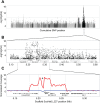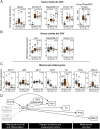A copy number variant is associated with a spectrum of pigmentation patterns in the rock pigeon (Columba livia)
- PMID: 32433666
- PMCID: PMC7239393
- DOI: 10.1371/journal.pgen.1008274
A copy number variant is associated with a spectrum of pigmentation patterns in the rock pigeon (Columba livia)
Abstract
Rock pigeons (Columba livia) display an extraordinary array of pigment pattern variation. One such pattern, Almond, is characterized by a variegated patchwork of plumage colors that are distributed in an apparently random manner. Almond is a sex-linked, semi-dominant trait controlled by the classical Stipper (St) locus. Heterozygous males (ZStZ+ sex chromosomes) and hemizygous Almond females (ZStW) are favored by breeders for their attractive plumage. In contrast, homozygous Almond males (ZStZSt) develop severe eye defects and often lack plumage pigmentation, suggesting that higher dosage of the mutant allele is deleterious. To determine the molecular basis of Almond, we compared the genomes of Almond pigeons to non-Almond pigeons and identified a candidate St locus on the Z chromosome. We found a copy number variant (CNV) within the differentiated region that captures complete or partial coding sequences of four genes, including the melanosome maturation gene Mlana. We did not find fixed coding changes in genes within the CNV, but all genes are misexpressed in regenerating feather bud collar cells of Almond birds. Notably, six other alleles at the St locus are associated with depigmentation phenotypes, and all exhibit expansion of the same CNV. Structural variation at St is linked to diversity in plumage pigmentation and gene expression, and thus provides a potential mode of rapid phenotypic evolution in pigeons.
Conflict of interest statement
The authors have declared that no competing interests exist.
Figures





Similar articles
-
Introgression of regulatory alleles and a missense coding mutation drive plumage pattern diversity in the rock pigeon.Elife. 2018 Jul 17;7:e34803. doi: 10.7554/eLife.34803. Elife. 2018. PMID: 30014848 Free PMC article.
-
An allelic series at the EDNRB2 locus controls diverse piebalding patterns in the domestic pigeon.PLoS Genet. 2023 Oct 20;19(10):e1010880. doi: 10.1371/journal.pgen.1010880. eCollection 2023 Oct. PLoS Genet. 2023. PMID: 37862332 Free PMC article.
-
Population genomics reveals that a missense mutation in EDNRB2 contributes to white plumage color in pigeons.Poult Sci. 2024 Jan;103(1):103225. doi: 10.1016/j.psj.2023.103225. Epub 2023 Oct 31. Poult Sci. 2024. PMID: 38035860 Free PMC article.
-
Pigeonetics takes flight: Evolution, development, and genetics of intraspecific variation.Dev Biol. 2017 Jul 15;427(2):241-250. doi: 10.1016/j.ydbio.2016.11.008. Epub 2016 Nov 12. Dev Biol. 2017. PMID: 27847323 Free PMC article. Review.
-
Genetic and Molecular Basis of Feather Diversity in Birds.Genome Biol Evol. 2018 Oct 1;10(10):2572-2586. doi: 10.1093/gbe/evy180. Genome Biol Evol. 2018. PMID: 30169786 Free PMC article. Review.
Cited by
-
Calling Structural Variants with Confidence from Short-Read Data in Wild Bird Populations.Genome Biol Evol. 2024 Apr 2;16(4):evae049. doi: 10.1093/gbe/evae049. Genome Biol Evol. 2024. PMID: 38489588 Free PMC article.
-
Genomic variation responding to artificial selection on different lines of Pekin duck.Poult Sci. 2025 Feb;104(2):104785. doi: 10.1016/j.psj.2025.104785. Epub 2025 Jan 7. Poult Sci. 2025. PMID: 39813863 Free PMC article.
-
Whole-genome sequencing reveals the artificial selection and local environmental adaptability of pigeons (Columba livia).Evol Appl. 2021 Aug 5;15(4):603-617. doi: 10.1111/eva.13284. eCollection 2022 Apr. Evol Appl. 2021. PMID: 35505885 Free PMC article.
-
Exploring potentialities of avian genomic research in Nepalese Himalayas.Avian Res. 2021;12(1):57. doi: 10.1186/s40657-021-00290-5. Epub 2021 Oct 30. Avian Res. 2021. PMID: 34745641 Free PMC article. Review.
-
A large deletion at the cortex locus eliminates butterfly wing patterning.G3 (Bethesda). 2022 Apr 4;12(4):jkac021. doi: 10.1093/g3journal/jkac021. G3 (Bethesda). 2022. PMID: 35099556 Free PMC article.
References
Publication types
MeSH terms
Grants and funding
LinkOut - more resources
Full Text Sources

